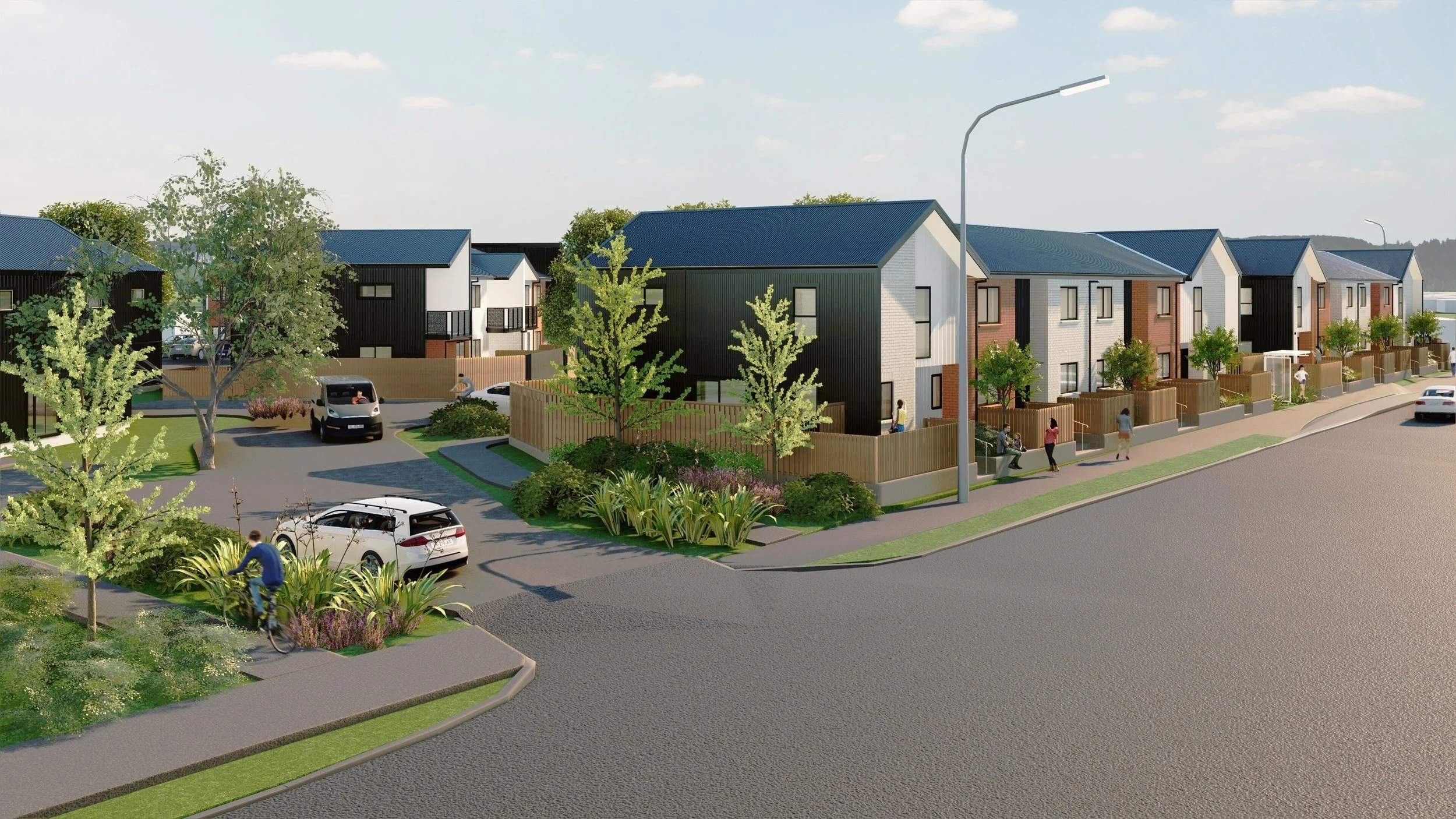Glue Place legacy will be set in concrete
An artists view of the new affordable homes planned for the former Glue Place site on the corner of Sparks Road and Lyttelton Street.
ŌCHT will build upon 60 years of heritage when it redevelops a former social housing site in Somerfield - and like its namesake, its history will be set in concrete.
Work has started to convert Glue Place, a cul-de-sac on the corner of Sparks Road and Lyttelton Street, into three separate communities of affordable and community housing homes.
The tired social housing units previously there were retired early last year. The name Glue Place has also been retired ahead of three new lanes being formed to service the new homes.
The new lanes will be called Te Uru Kahikatea Lane, Te Koroī Lane and Te Māpara Lane. The names refer to the kahikatea trees that once covered the area.
The Waihoro Spreydon-Cashmere-Heathcote Community Board accepted the names and has asked the Trust to acknowledge Glue Place’s heritage with “a permanent setting”.
A permanent plaque will say Glue Place is named after William (Bill) Percy Glue (1888-1980), a city councillor from 1941 to 1971.
But it won’t be big enough to capture Bill Glue’s interesting story.
William (Bill) Glue at retirement, 1971. PHOTO: The Star
Older Christchurch residents may remember Bill was a long-term city councillor and a one-time mayoral candidate involved in myriad public offices.
Fewer may remember him as an influential builder and the inventor of a construction system used in many notable homes around the city.
Bill was born in Melbourne, Australia before his family emigrated to Dunedin. He left school at 10 and started his life in construction as a painter.
He was a builder by 1914 when he invented and patented a hollow-wall concrete construction system which he called Simplex.
The Simplex system formed walls of two layers of steel-reinforced concrete with a cavity in between.
It was revolutionary: most people were building bungalows with timber gables and windows.
Bill built his first concrete house in Timaru before he moved to Dunedin to do more of the same in partnership with Walter Ellis, in their business Ellis and Glue.
His wife Kitty’s health deteriorated in damp, cold Dunedin and by 1923 they were in Christchurch with his carpenter brother, Walter. They formed their company Glue Brothers and with his Simplex system, they set about capitalising on the Fendalton building boom.
Glue Bros built many of the affluent suburb’s notable homes, mainly along Idris, Snowdon, Clyde and Glandovey roads. Many are still in use today.
Bill successfully stood for council in 1941, and for the next three decades was part of all manner of organisations.
His unavoidably long list of involvements includes the Christchurch Drainage Board, the Rural Electrical Reticulation Council, the Pollution Advisory Council, Papanui High School's Board of Governors, the Canterbury Museum Trust Board, the Christchurch Metropolitan Milk Board, the Canterbury Progress League, the South Island Publicity Association, the Christchurch Regional Planning Authority, the Lyttleton Harbour Board, Riccarton Bush Trust, the Selwyn Plantation Board, and the Christchurch-Lyttleton Tunnel Authority.
Kitty was also very active in their community, especially in social welfare work. She was well known for her work with the North Canterbury Centre of the NZ Red Cross Society, and the Fendalton branch of the Plunket Society.
Bill resigned from the council to stand for the 1958 mayoralty by-election. He didn't get elected but he was re-elected to the council. Bill was awarded an OBE in 1958 and a yet-to-be-built new pensioner housing complex planned for Somerfield was named Glue Place two years later.
When he eventually retired from public life in 1971, The Star newspaper reported the council had lost “an old workhorse” whose success was due to his stamina and ability to delegate.
Bill died after a long illness in 1980, his name ever associated with some of the city’s grandest homes and a social housing complex that provided homes for those in need for more than 60 years.
Site work starts at Glue Place in August, 2024.




